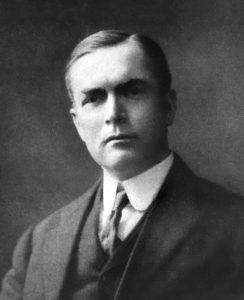Training and first commitments
Willem Visser’t Hooft was born in Haarlem (the Netherlands) in 1900, in a family of lawyers linked to remonstrating Protestantism. The community to which Rembrandt belonged developed mainly in the Netherlands after a memorable discussion on the meaning of predestination in 1610. It refused any fundamentalist or determinist reading of the Bible.
After a traditional schooling, he started studying law but changed to study theology. He took on responsibilities with the Young Men Christian Associations (YMCA) and its students branch, the World Student Christian Federation (WSCF). As such, he took part in international meetings created after the Edinburgh Conference in1910, such as the International Missionary Council (IMC) in 1921, the Stockholm Conference on Christian life and work in 1925, or the Lausanne Conference Faith and Order in 1927, which specifically dealt with theological and dogmatic problems. All these themes tried to define the mission of the Church in a rapidly changing world, highly unstable after World War I. He often met John Mott, Ruth Rouse, Joseph H. Oldham, William Temple, Pierre Maury, etc. and discovered Karl Barth’s writings and their theological requirements and helped many others discover them.
In 1924 he was appointed secretary general of the YMCA, and was ordained a pastor. The same year he married Henriette Boddaert (1899-1968). The couple settled down in Geneva and never left.
Henriette Boddaert and Willem Wisser’t Hooft had three children.
Pathfinder of the temporary ecumenical Council of Churches
In 1932 Willem Visser’t Hooft stepped down from the YMCA and became general secretary of the WSCF. As all others committed to ecumenical entities, he was confronted by the difficult context of the social consequences of the 1929 economic crisis could be strongly felt in the workplace; as Nazism was definitely growing in Germany. In 1938 in Utrecht Protestants and members of the Orthodox Church met. Representatives of the Faith and Order and Life and Work movements created a temporary constitution for the ecumenical World Council of Churches. The entity in progress had to bring them together in a common body. Willem Visser’t Hooft was appointed general secretary. Soon after World War II broke out, and the immediate emergency was to find shelter and help for all those who had to flee from Germany. He was aided by a group of men and women, many of them non-religious. Together by various means they also supported resistance forces developing in the German Confessing Church and in countries under Nazi rule, for instance it promoted and took part in writing the Pomeyrol Theses. They reflected on the missions and initiatives the WCC would have to manage after the restoration of peace.
General Secretary of the Ecumenical World Council of Churches
After the war the WCC needed durable and effective structures to bring into being a brotherhood of Protestant and Anglican Churches ; to be able to open up to other Churches, especially Orthodox Churches. Willem Visser’t Hooft along with various theologians and laypeople set about their work. The Roman Catholic Church refused any form of partnership considering itself alone the place of visible unity.
After the First Assembly was held in Amsterdam in 1948, Willem Visser’t Hooft was elected General Secretary. So started the reflection and work towards a shared Evangelical hope, to make the earth more live-able (oikumene). The concrete steps involved addressing unequal conditions causing injustice, violence, racism, notably those linked to decolonisation. Action was also focused on education.
To implement the programmes and to find useful relays, Willem Visser’t Hooft promoted meetings and diplomatic actions. A department of International Affairs was created. Links with other international entities, particularly the UN, were developed. But first and foremost during the Cold War, Willem Visser’t Hooft kept contacts with Churches in the East.
During the Vatican II Council in 1961, Willem Visser’t Hooft built a trusting relationship with Cardinal Bea (1881-1968) and his fellow-countryman Cardinal Willebrands (1909-2006), both in charge of the Secretariat for Christian Unity that Pope John XXIII had just set up.
As he stepped down in 1966, the number of member churches had increased from 147 to 197. Many projects had been created, especially in the relationship between Churches and society which became the Church and Society conference report.
Honorary President of the WCC
Willem Visser’t Hooft was elected Honorary President of the WCC in 1966 to acknowledge his outstanding involvement in the ecumenical movement. He still attended general assemblies and seminars of the organisation until he died in 1985.











